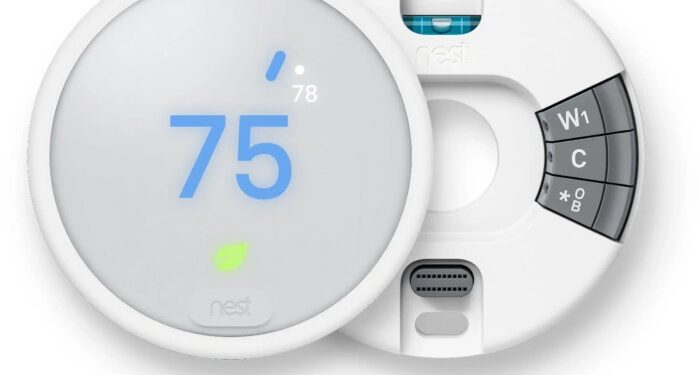Exploring the world of smart thermostats and finding the best buy can be an exciting journey. From understanding what makes a smart thermostat unique to comparing top brands and features, this guide will help you make an informed decision for your home.
When it comes to smart thermostats, the possibilities are endless. With innovative technology and energy-saving benefits, these devices are transforming the way we control our indoor climate.
Introduction to Smart Thermostats
A smart thermostat is a device that allows you to control the heating and cooling of your home remotely through a smartphone or other connected device. It uses sensors and algorithms to learn your habits and adjust the temperature accordingly, providing a more efficient and convenient way to manage your home's climate.Benefits of Using a Smart Thermostat
- Energy Savings: Smart thermostats can help reduce energy consumption by automatically adjusting the temperature based on your habits and preferences, leading to lower utility bills.
- Convenience: With the ability to control your thermostat from anywhere, you can easily adjust the temperature to your liking without having to be at home.
- Comfort: Smart thermostats can create a more comfortable living environment by maintaining a consistent temperature throughout the day.
- Remote Monitoring: You can monitor your home's temperature and energy usage even when you're away, giving you peace of mind and the ability to make adjustments as needed.
How Smart Thermostats Differ from Traditional Thermostats
Unlike traditional thermostats that require manual adjustment, smart thermostats use advanced technology to learn your habits and preferences, automatically adjusting the temperature for optimal comfort and energy savings. They also offer features like remote access, scheduling, and energy usage reports that traditional thermostats lack, making them a more efficient and convenient option for controlling your home's climate.Features to Consider
When choosing a smart thermostat, there are several key features to consider that can enhance its functionality and convenience. These features can vary depending on the model and brand, so it's essential to understand what each one offers before making a decision.Connectivity Options
- Wi-Fi: Smart thermostats with Wi-Fi connectivity allow you to control your home's temperature remotely through a smartphone app or web portal. This feature enables you to adjust settings, create schedules, and monitor energy usage from anywhere, providing convenience and flexibility.
- Bluetooth: Some smart thermostats use Bluetooth technology to connect with other devices within close proximity. While Bluetooth may not offer the same range as Wi-Fi, it can still provide reliable communication between your thermostat and compatible devices, such as sensors or smart assistants.
- Smart Home Integration: Look for smart thermostats that are compatible with popular smart home platforms like Amazon Alexa, Google Assistant, or Apple HomeKit. This integration allows you to control your thermostat using voice commands and automate temperature adjustments based on other smart devices in your home.
Compatibility with HVAC Systems
It's crucial to ensure that the smart thermostat you choose is compatible with your home's heating, ventilation, and air conditioning (HVAC) system. Different thermostats support various HVAC configurations, such as single-stage, multi-stage, heat pump, or radiant heating. Checking compatibility can prevent compatibility issues and ensure optimal performance.
Best Buy Smart Thermostat Brands
When it comes to smart thermostats, there are several top brands known for producing quality products that offer innovative features and functionality. Let's take a look at some of the most popular brands and compare their pricing and features to help you make an informed decision.Nest
Nest, owned by Google, is one of the leading brands in the smart thermostat market. Known for its sleek design and user-friendly interface, Nest thermostats are popular for their energy-saving capabilities. The Nest Learning Thermostat and Nest Thermostat E are two of their most popular models, offering features like learning algorithms, remote access, and compatibility with smart home systems.Ecobee
Ecobee is another well-respected brand that offers a range of smart thermostats known for their advanced sensors and compatibility with voice assistants like Amazon Alexa and Google Assistant. The Ecobee SmartThermostat with voice control and Ecobee3 Lite are among their top models, providing features like room sensors, energy reports, and easy installation.Honeywell
Honeywell is a trusted name in the thermostat industry, offering a variety of smart thermostats that cater to different preferences and budgets. Their Honeywell Home T9 Smart Thermostat and Honeywell Home T5+ Smart Thermostat are popular choices, featuring customizable schedules, geofencing, and smart response technology for optimal comfort.Emerson
Emerson is known for its Sensi line of smart thermostats, which are designed to provide simple and practical solutions for homeowners. The Emerson Sensi Touch Smart Thermostat and Emerson Sensi Wi-Fi Thermostat offer features like flexible scheduling, energy usage tracking, and easy integration with smart home platforms like Apple HomeKit and Amazon Alexa.Comparison
When comparing these brands, pricing can vary depending on the features and capabilities of each model. Nest thermostats are typically priced at a premium level, while Ecobee and Honeywell offer more budget-friendly options without compromising on quality. Emerson falls somewhere in between, providing affordable yet reliable smart thermostat solutions.Installation and Setup
When it comes to setting up a smart thermostat, the process can vary depending on the model and brand you choose. However, most smart thermostats are designed to be user-friendly and come with detailed instructions to help you through the installation process.Ease of Installation
Installing a smart thermostat is usually a straightforward process that can be completed in just a few steps. Here is a general guide on how to set up a smart thermostat:- Turn off the power to your HVAC system at the breaker.
- Remove your old thermostat from the wall and label the wires.
- Mount the new thermostat base on the wall and connect the labeled wires.
- Follow the manufacturer's instructions to complete the setup on the thermostat display.
- Turn the power back on at the breaker and test the thermostat to ensure it is working properly.
Troubleshooting Installation Issues
If you encounter any issues during the installation process, here are some common problems and tips to help you troubleshoot:- Incorrect wiring: Double-check that the wires are connected to the correct terminals on the thermostat.
- No power: Make sure the power switch is on and the breaker is not tripped.
- Wi-Fi connection problems: Ensure that your Wi-Fi network is working properly and that the thermostat is within range.
- Compatibility issues: Check if your HVAC system is compatible with the smart thermostat model you have chosen.
Energy Efficiency and Cost Savings
Smart thermostats play a crucial role in conserving energy and reducing utility bills for households. By offering advanced features and capabilities, these devices help optimize heating and cooling systems, resulting in significant cost savings over time.Energy-Saving Features of Smart Thermostats
- Programmable Schedules: Smart thermostats allow users to create customized heating and cooling schedules based on their daily routines. This feature ensures that energy is not wasted when the house is unoccupied.
- Remote Access: With remote access via smartphone apps, users can adjust temperature settings even when they are away from home. This helps in preventing unnecessary energy consumption when no one is at home.
- Learning Algorithms: Some smart thermostats come equipped with learning algorithms that adapt to users' preferences over time. By learning the household's heating and cooling patterns, these devices optimize energy usage efficiently.
- Energy Usage Reports: Smart thermostats provide detailed energy usage reports, allowing users to track their consumption patterns and make informed decisions to reduce energy waste.
Real-Life Cost Savings Examples
Case Study: A family installed a smart thermostat in their home and saw a 10% reduction in their heating and cooling bills within the first year. By optimizing their HVAC system's performance, they were able to save up to $200 annually.
Example: A homeowner used the programmable schedule feature on their smart thermostat to adjust the temperature settings based on their work hours. As a result, they saved approximately 15% on their energy bills compared to the previous year.
User Experience and Interface
When it comes to smart thermostats, the user experience and interface play a crucial role in how users interact with the device on a daily basis. Let's delve into the user interface of popular smart thermostat models, compare user experiences with different brands, and discuss the ease of use and customization options available for users.User Interface of Popular Smart Thermostat Models
- Nest Learning Thermostat: The Nest thermostat features a sleek and intuitive interface with a rotating dial for easy navigation. Users can adjust the temperature by simply turning the dial or use the app for remote control.
- Ecobee SmartThermostat: Ecobee offers a user-friendly touchscreen interface that allows users to easily set schedules, view energy reports, and adjust settings. The interface is highly customizable, allowing users to personalize their experience.
- Honeywell Home T9: The Honeywell T9 thermostat comes with a simple and straightforward interface that provides users with essential information at a glance. Users can access advanced settings through the app for more customization options.
Comparison of User Experiences with Different Smart Thermostat Brands
- Nest: Users praise Nest for its user-friendly interface and seamless integration with other smart home devices. The learning capabilities of the Nest thermostat also enhance user experience over time.
- Ecobee: Ecobee is known for its advanced scheduling features and detailed energy reports, providing users with valuable insights into their heating and cooling patterns.
- Honeywell: Honeywell offers a reliable and straightforward user experience, appealing to users who prefer a no-frills approach to smart thermostat operation.
Ease of Use and Customization Options
- All three brands mentioned above offer easy installation processes and user-friendly interfaces, making it simple for users to control their home's temperature.
- Customization options vary between brands, with Ecobee standing out for its extensive customization features, allowing users to tailor their settings to fit their lifestyle and preferences.
- Whether you prefer a more hands-off approach with learning capabilities like Nest or enjoy fine-tuning settings with Ecobee, each brand offers a unique user experience catered to different preferences.
Maintenance and Support
Smart thermostats are designed to be low maintenance devices that can help optimize energy usage in your home. However, there are still some maintenance requirements to keep in mind to ensure they continue to function efficiently.Maintenance Requirements
- Regularly check and replace batteries if your smart thermostat is battery-operated.
- Keep the thermostat clean by gently wiping it with a soft, dry cloth to prevent dust buildup.
- Ensure the thermostat is securely mounted on the wall to avoid any issues with temperature readings.
Warranty and Support Options
Most smart thermostat manufacturers offer warranties to cover any defects or malfunctions. It's essential to register your device and keep a record of the warranty period to take advantage of any support options available. Manufacturers also provide customer support services, such as online resources, FAQs, and helplines, to assist with any troubleshooting or installation queries.Tips for Longevity and Performance
- Regularly update the firmware of your smart thermostat to ensure it has the latest features and security patches.
- Avoid exposing the thermostat to extreme temperatures or humidity levels that could affect its functionality.
- Consider investing in a surge protector to protect your smart thermostat from power surges that could damage its internal components.















